How does Uganda coffee taste? Uganda Vinzori Mountain Coffee Introduction Uganda Coffee Features
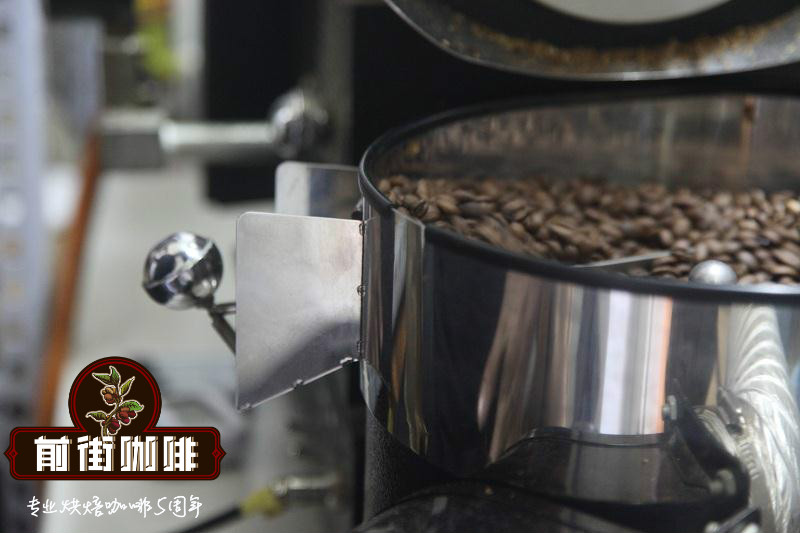
Professional coffee knowledge exchange more coffee bean information please follow the coffee workshop (Wechat official account cafe_style)
Uganda is remembered as a very poor country, but what Qianjie wants to share today is boutique coffee from Uganda, anaerobic tanning from the Wenzori Mountains. Coffee is a very important cash crop in Uganda, although the production of boutique coffee is relatively small, but it does not prevent Qianjie from looking for good local coffee. This anaerobic sun treatment is the good coffee found in Qianjie. After cup testing and brewing, it is found that spices and nuts are the main notes of this coffee, thanks to the anaerobic flavor of fermented wine, mellow taste with cream, peanuts, with soft acidity, without losing layers.
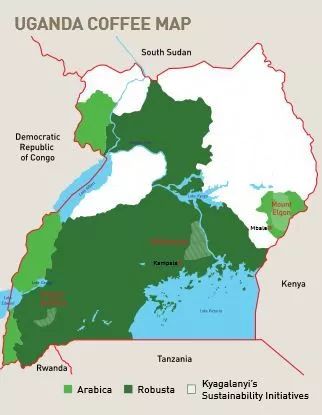
Uganda is located at the source of the Nile, a landlocked country not off the sea in Africa. Although it has a long history of producing coffee like other East African countries, the quality of coffee has never been improved because of the war caused by ethnic antagonism. Most of the good coffee here is grown in areas adjacent to Kenya, and some good coffee beans are shipped to Kenya to be sold as Kenyan coffee, and Uganda did not leap into a fast-growing country until the war stopped 15 years ago. Uganda has lush green forests, lakes, wetlands and abundant rivers. Coffee is the largest crop in Uganda. About 500000 coffee farms are engaged in coffee-related agriculture, accounting for 25% of the total population. Coffee trees are mostly robusta coffee trees, which account for about 94% of coffee cultivation in Uganda, and only 6% are traditional Arabica trees. These rare coffee beans grow in tropical rain forests, and most of them are exported to countries around the world.
In Uganda, coffee exports account for 20% of the country's GDP and are the most important export products, but most of them are robusta coffee of low quality in the international market. Uganda is rarely seen on the map of boutique coffee in the world, on the contrary, it is mostly in Ethiopia, Kenya and Tanzania and other countries. Because of the topography, Arabica coffee can only be grown on the slopes of the east and southwest. In fact, Arabica coffee trees were introduced into eastern Uganda from Ethiopia more than 200 years ago. In the Mbale (east) area, coffee has been grown for a long time, and almost every household has coffee trees, but in the past, coffee was bought by middle-market merchants, no matter the quality was good or bad. Prices fluctuate with the market, and farmers have no incentive to work together to grow better coffee beans.
The Mt Rwenzori Mountains, known as the "Mountains of the Moon", are located in western Uganda and are the border between Uganda and the Democratic Republic of the Congo (DRC). Coffee is Uganda's main cash crop, accounting for 95% of Uganda's total exports.
Treatment: after the fresh coffee fruit is ripe, it is picked by hand, soaked in a fermentor, fermented and then dried.
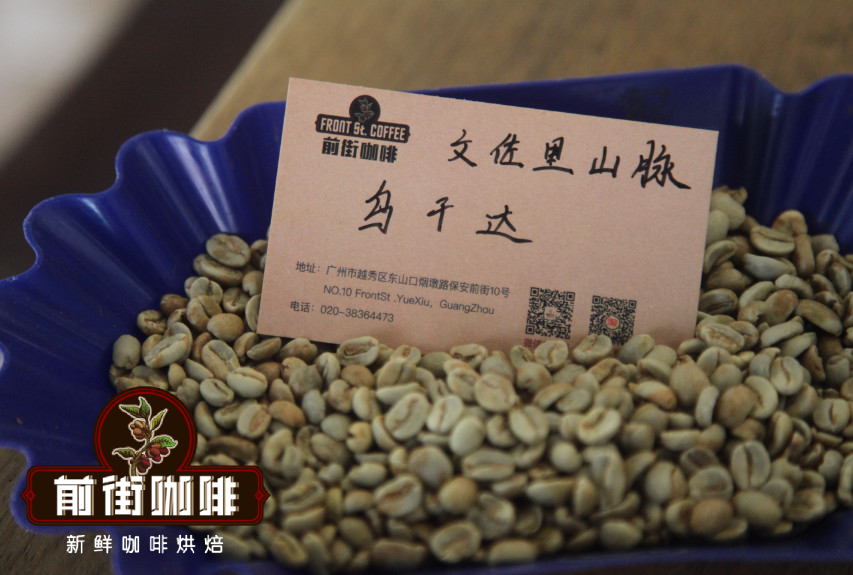
Analysis of raw beans of Qianjie coffee
This bean is made up of SL14 and SL28, both of which are common in Uganda! The SL variety comes from the development and selection of Scott Lab. Kenyan coffee is world-famous for SL28 and SL34, so the Ugandan government vigorously promotes and distributes SL seeds to farmers. Among them, SL14 not only has good flavor and drought resistance, but also can be harvested after planting for two years, which meets the needs of farmers. Raw beans look different in size, yellowish green in color, and smell like grass.
Qianjie coffee roasting analysis roaster Yangjia 800N (roasting capacity 300g)
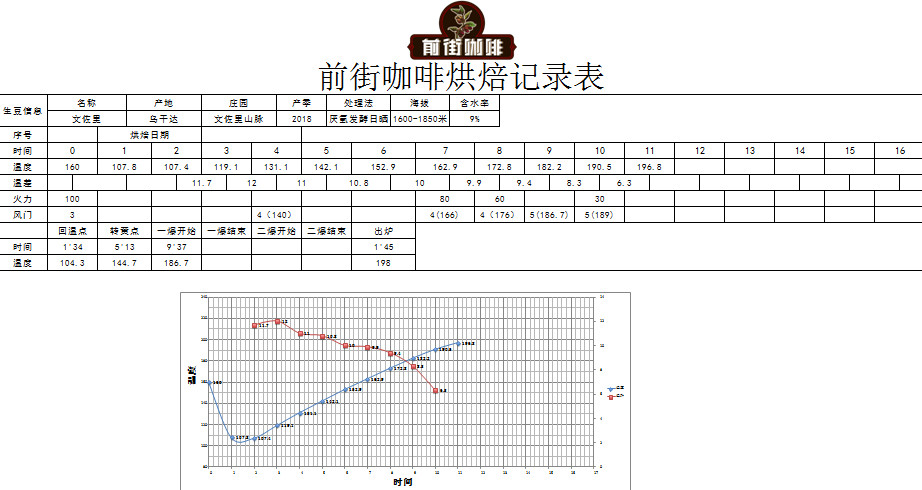
The furnace temperature is 160℃ and the firepower is 100. the throttle is open to 4 at 140℃, and the firepower remains unchanged; when the furnace temperature is 144.7 ℃, the bean meter turns yellow, the smell of grass disappears completely, and enters the dehydration stage. When the furnace temperature reaches 166℃, the firepower is adjusted to 80, and the throttle remains unchanged. The smell of toasted bread has obviously changed to the smell of coffee, which can be defined as a prelude to an explosion. At this time, it is necessary to listen carefully to the sound of the explosion point, until the sound of the explosion point starts to explode, and the throttle opens to 5. After an explosion, the development of a cup of bread 39 leaves 45198 ℃ into the pot.
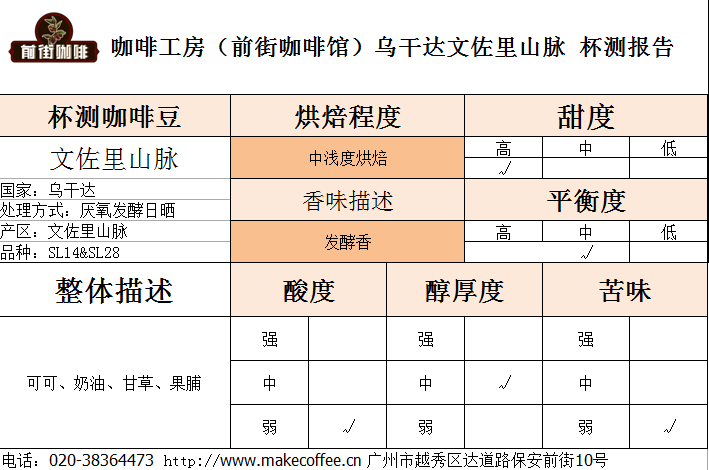
Agtron bean color value is 68.4 (left), Agtron pink value is 75.9 (right), Roast Delta value is 7.5.
Qianjie coffee cup test flavor: cocoa, cream, licorice, preserved fruit
Anaerobic solarization in the Wenzori Mountains of Uganda
Country: Uganda
Producing area: Wenzori Mountains
Altitude: 1600-1800 m
Treatment method: anaerobic treatment of solarization
Variety: SL14&SL28

Qianjie coffee brewing analysis | filter cup: V60 water temperature: 90 ℃ powder / water ratio: 1:15 Grinding degree: medium and fine grinding, that is, fine sugar thickness (BG 6L: Chinese standard 20 sieve pass rate 80%)
Qianjie coffee brewing technique: segmented extraction. Steam with 35 grams of water for 25 seconds, circle water injection to 130 grams, continue water injection to 227 grams when the water level is about to be exposed, and remove the filter cup when the water level is about to expose the powder bed. (the time of steaming starts) the extraction time is 1: 39: 50 ".
Flavor: it smells with a hint of fermented aroma, with cocoa, cream, peanuts and soft acid.

Important Notice :
前街咖啡 FrontStreet Coffee has moved to new addredd:
FrontStreet Coffee Address: 315,Donghua East Road,GuangZhou
Tel:020 38364473
- Prev
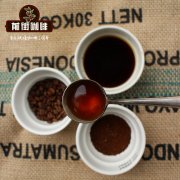
Panama Red Standard Rose Summer Independent auction Jade auction for the first time appeared "failed auction" special treatment batch
Professional coffee knowledge exchange more coffee bean information Please follow Coffee Workshop (Wechat official account cafe_style) this year's auction added yeast processing lots, which has become a highlight of this year's auction. A total of 15 Rosa rosacea with different treatments were auctioned: 9 sun-dried Rosa, 4 yeast-treated Rosa, and 2 traditional water-washed Rosa. As an auction activity born out of BOP, Hong
- Next
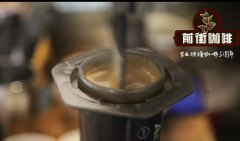
Uganda Peace Kawomera Cooperative Coffee introduction to Uganda Coffee varieties
For more information on coffee beans, please follow the coffee workshop (Wechat official account cafe_style) the source of the Nile in Uganda is a landlocked country not close to the sea in Africa. Although it has a long history of producing coffee like other East African countries, the quality of coffee has never been improved because of the war caused by ethnic antagonism. Good coffee is mostly grown in areas adjacent to Kenya.
Related
- Detailed explanation of Jadeite planting Land in Panamanian Jadeite Manor introduction to the grading system of Jadeite competitive bidding, Red bid, Green bid and Rose Summer
- Story of Coffee planting in Brenka region of Costa Rica Stonehenge Manor anaerobic heavy honey treatment of flavor mouth
- What's on the barrel of Blue Mountain Coffee beans?
- Can American coffee also pull flowers? How to use hot American style to pull out a good-looking pattern?
- Can you make a cold extract with coffee beans? What is the right proportion for cold-extracted coffee formula?
- Indonesian PWN Gold Mandrine Coffee Origin Features Flavor How to Chong? Mandolin coffee is American.
- A brief introduction to the flavor characteristics of Brazilian yellow bourbon coffee beans
- What is the effect of different water quality on the flavor of cold-extracted coffee? What kind of water is best for brewing coffee?
- Why do you think of Rose Summer whenever you mention Panamanian coffee?
- Introduction to the characteristics of authentic blue mountain coffee bean producing areas? What is the CIB Coffee Authority in Jamaica?

